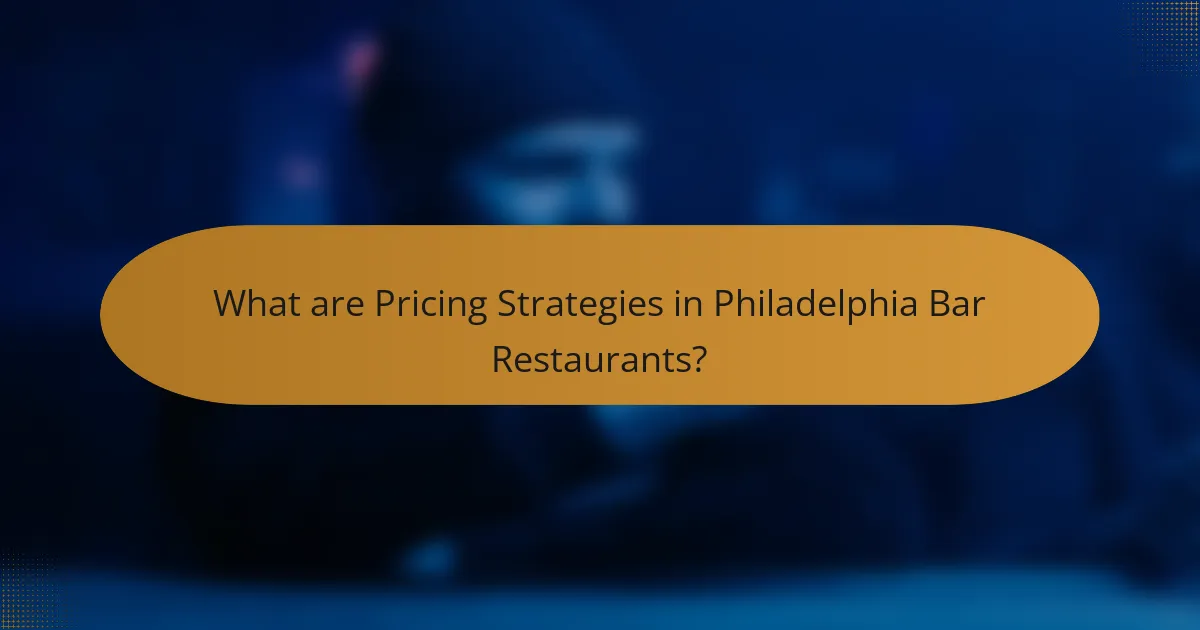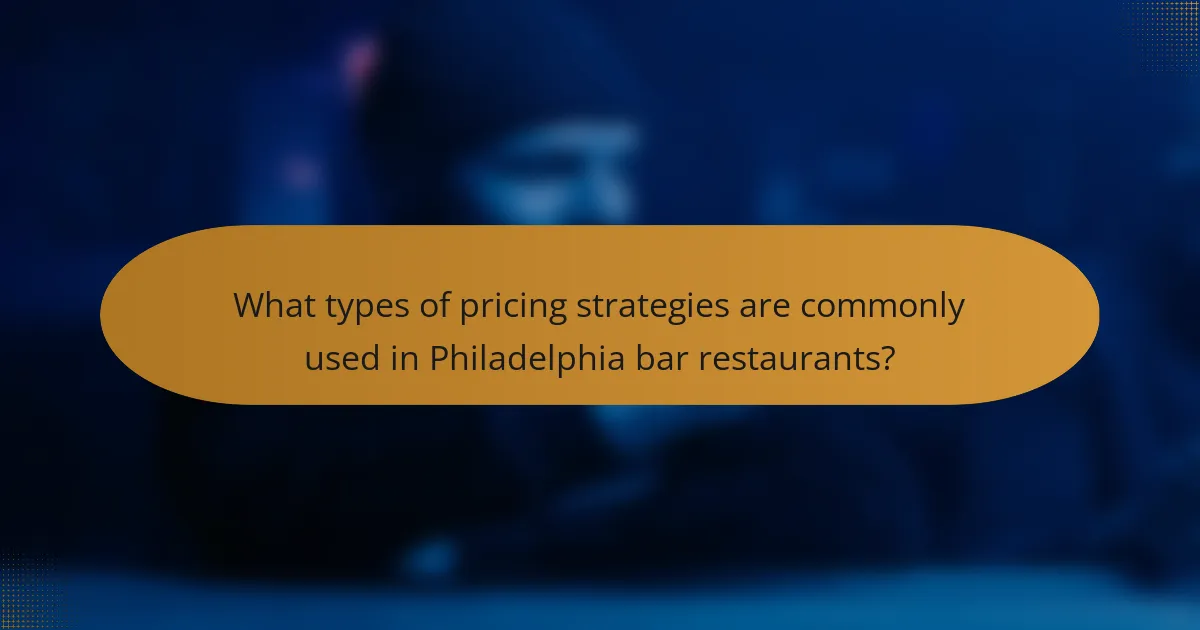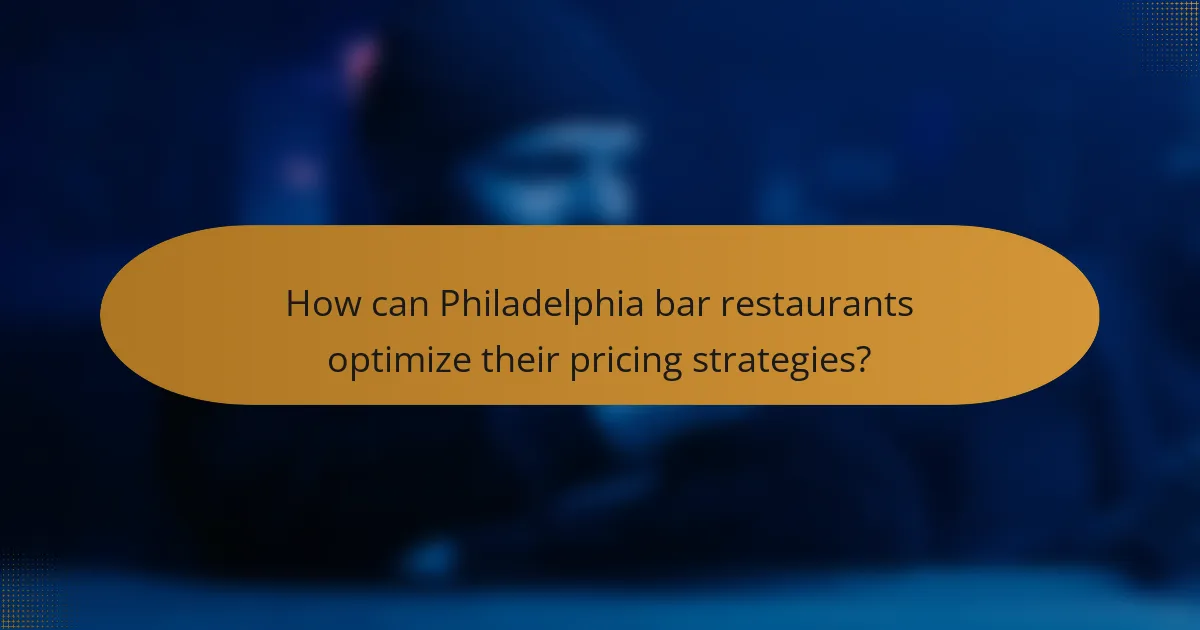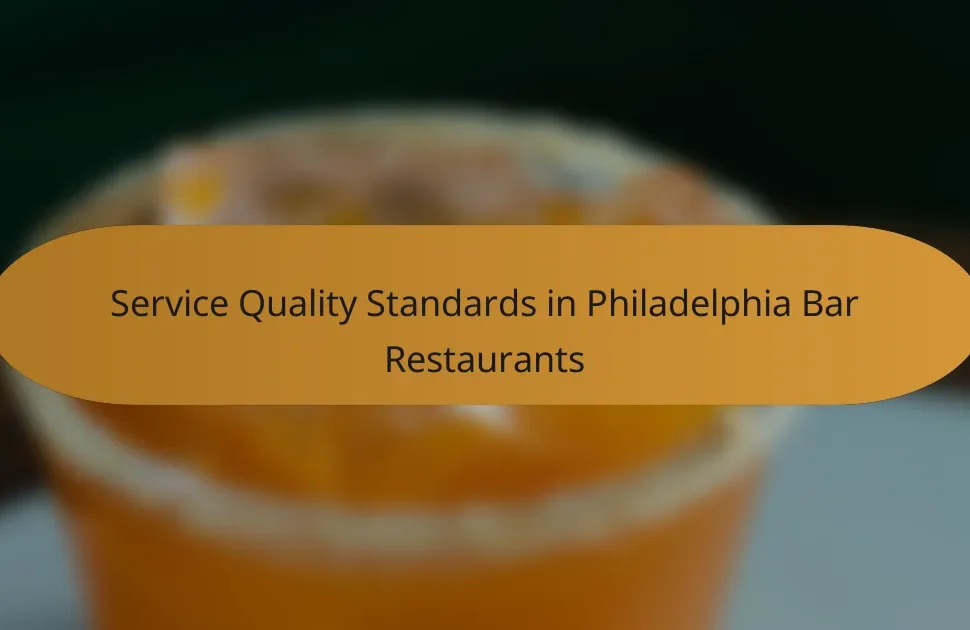
What are Pricing Strategies in Philadelphia Bar Restaurants?
Pricing strategies in Philadelphia bar restaurants often include competitive pricing, value-based pricing, and dynamic pricing. Competitive pricing involves setting prices based on competitors’ rates to attract customers. Value-based pricing focuses on the perceived value of the offerings, ensuring customers feel they receive quality for their money. Dynamic pricing adjusts prices based on demand fluctuations, special events, or peak hours.
These strategies are essential for maintaining profitability while appealing to a diverse clientele. For example, during happy hours, many establishments lower prices to increase foot traffic. According to a 2023 survey by the Pennsylvania Restaurant and Lodging Association, 67% of bar restaurants in Philadelphia reported using some form of promotional pricing to boost sales. This demonstrates the importance of pricing strategies in a competitive market.
How do pricing strategies influence customer perception in bar restaurants?
Pricing strategies significantly influence customer perception in bar restaurants. Customers often associate higher prices with better quality and exclusivity. Conversely, lower prices can lead to perceptions of lower quality or value.
Research shows that perceived value is crucial in customer decision-making. A study by Monroe (2003) highlights that customers evaluate price against their expectations of quality. For example, if a bar restaurant prices its craft beers higher than competitors, customers may perceive it as offering a superior experience.
Moreover, promotional pricing can attract new customers but may alter long-term perceptions. Discounts can create a sense of urgency but may also lead to doubts about regular pricing.
In summary, pricing strategies shape customer expectations and experiences in bar restaurants.
What factors contribute to the perceived value of pricing in bar restaurants?
Factors that contribute to the perceived value of pricing in bar restaurants include quality of food and drinks, ambiance, and customer service. High-quality ingredients enhance the dining experience. Unique or well-crafted cocktails can also elevate perception. The overall atmosphere, including decor and music, influences customer satisfaction. Excellent service can justify higher prices. Additionally, location impacts pricing; bars in prime areas may charge more. Promotions and loyalty programs can enhance perceived value. Lastly, customer reviews and word-of-mouth recommendations play a significant role in shaping perceptions.
How does location impact pricing strategies in Philadelphia bar restaurants?
Location significantly impacts pricing strategies in Philadelphia bar restaurants. Restaurants in high-traffic areas tend to charge higher prices due to increased demand. Areas with a vibrant nightlife attract customers willing to pay more for convenience. Conversely, establishments in less frequented neighborhoods often adopt competitive pricing to attract patrons. The local demographic also influences pricing; affluent areas can support higher price points. Additionally, proximity to tourist attractions allows for premium pricing due to the influx of visitors. Market research indicates that location accounts for up to 30% of a restaurant’s pricing strategy. Therefore, Philadelphia bar restaurants must adapt their pricing based on their specific location dynamics.
Why is balancing quality and affordability important in pricing strategies?
Balancing quality and affordability is crucial in pricing strategies to attract and retain customers. Customers seek value for their money. If prices are too high without perceived quality, sales may decline. Conversely, low prices may compromise quality perception. Research indicates that 70% of consumers consider quality more important than price. A balanced approach enhances customer satisfaction. It fosters loyalty and encourages repeat business. This balance can differentiate a restaurant in a competitive market. In Philadelphia, where dining options are abundant, this strategy is essential for success.
What role does customer demographic play in determining pricing strategies?
Customer demographics significantly influence pricing strategies in the restaurant industry. Factors such as age, income, and lifestyle affect customers’ willingness to pay. For instance, younger customers may prefer lower-priced options, while higher-income demographics might be open to premium pricing.
Restaurants often analyze demographic data to tailor their menus and pricing accordingly. In Philadelphia, bar restaurants may adjust prices based on the local population’s income levels and spending habits. Research shows that businesses targeting affluent neighborhoods can implement higher pricing strategies successfully.
Conversely, establishments in lower-income areas may need to focus on affordability to attract customers. Understanding customer demographics leads to more effective pricing strategies, ultimately enhancing profitability and customer satisfaction.
How can bar restaurants maintain quality while keeping prices affordable?
Bar restaurants can maintain quality while keeping prices affordable by optimizing their supply chain and menu offerings. Streamlining suppliers can reduce costs without sacrificing ingredient quality. Utilizing seasonal and local ingredients often lowers expenses and enhances freshness. Implementing efficient kitchen operations minimizes waste and labor costs. Offering a focused menu can reduce inventory costs and simplify preparation. Additionally, leveraging technology for inventory management can further decrease overhead. These strategies collectively help bar restaurants provide quality food and drinks at competitive prices.

What types of pricing strategies are commonly used in Philadelphia bar restaurants?
Philadelphia bar restaurants commonly use several pricing strategies. These include competitive pricing, where prices are set based on competitors’ rates. Value-based pricing is also prevalent, focusing on perceived customer value. Happy hour promotions are frequently employed to attract patrons during off-peak times. Bundle pricing, which offers discounts on combined items, is another strategy used to increase sales. Seasonal pricing adjusts rates based on demand fluctuations throughout the year. These strategies help bar restaurants balance quality and affordability while remaining competitive in the market.
How do competitive pricing strategies work in the bar restaurant industry?
Competitive pricing strategies in the bar restaurant industry involve setting prices based on competitors’ pricing. This strategy aims to attract customers by offering similar or lower prices than nearby establishments. Bar restaurants analyze their competitors’ menus and price points to determine the optimal pricing for their offerings. By doing so, they can position themselves effectively in the market.
For instance, if a competitor offers a craft beer at $6, a bar restaurant may choose to price a similar beer at $5.50 to entice customers. Additionally, these establishments may implement promotions or discounts to further enhance their appeal. Research indicates that 70% of consumers consider price as a key factor when choosing where to dine.
In conclusion, competitive pricing strategies help bar restaurants remain attractive and relevant in a crowded market.
What are the advantages and disadvantages of competitive pricing?
Competitive pricing offers several advantages and disadvantages. One advantage is that it helps attract price-sensitive customers. By setting prices similar to competitors, businesses can remain relevant in the market. This strategy can increase market share and drive sales volume. Additionally, competitive pricing encourages businesses to improve product quality and service to differentiate themselves.
On the downside, competitive pricing can lead to reduced profit margins. When prices are driven too low, it may become challenging to cover costs. This may result in financial strain on the business. Furthermore, constant price competition can create a price war, negatively impacting the entire industry. Businesses may also struggle to maintain brand value if they focus solely on price.
How do bar restaurants differentiate themselves using pricing strategies?
Bar restaurants differentiate themselves using pricing strategies by implementing tiered pricing models and unique promotions. Tiered pricing allows them to offer various price points, catering to different customer segments. For instance, they may have premium priced items that appeal to high-end clientele. Conversely, they can offer lower-priced options to attract budget-conscious patrons.
Unique promotions, such as happy hours or themed nights, create a competitive edge. These promotions often feature discounted drinks or food items, enticing customers to visit during specific times. According to a survey by the National Restaurant Association, 73% of consumers are influenced by price when choosing a restaurant.
Additionally, bar restaurants may use psychological pricing strategies, such as pricing items at $9.99 instead of $10. This subtle difference can increase sales by making items appear more affordable. By combining these strategies, bar restaurants effectively attract diverse customer bases while maintaining profitability.
What is value-based pricing and how is it applied in bar restaurants?
Value-based pricing is a pricing strategy where prices are set based on the perceived value to the customer rather than the cost of the product. In bar restaurants, this approach involves understanding customer preferences and willingness to pay for specific drinks and food items. Bar restaurants assess the quality, ambiance, and unique offerings to determine pricing. For example, a craft cocktail may be priced higher due to its artisanal ingredients and presentation. This strategy helps bar restaurants maximize revenue by aligning prices with customer expectations. Research shows that businesses using value-based pricing can increase profitability by up to 20%.
How do bar restaurants assess customer willingness to pay?
Bar restaurants assess customer willingness to pay through various methods. They often utilize surveys to gather direct feedback from patrons about pricing preferences. Menu pricing experiments help gauge reactions to different price points. Analyzing sales data provides insights into customer spending behavior. Competitor pricing analysis allows bar restaurants to position themselves effectively in the market. Customer demographics and psychographics are also considered to tailor offerings. Additionally, social media engagement can reveal customer perceptions of value. These methods combined create a comprehensive understanding of what customers are willing to spend.
What techniques can bar restaurants use to implement value-based pricing?
Bar restaurants can implement value-based pricing by assessing customer perceptions of value. This involves understanding what customers prioritize, such as quality, service, and ambiance.
Conducting market research helps identify competitors’ pricing and customer preferences. Utilizing customer feedback allows bar restaurants to refine their offerings based on actual consumer desires.
Offering tiered pricing for different menu items can also enhance perceived value. For example, premium options can be priced higher due to perceived quality.
Additionally, creating bundled deals can provide perceived savings while increasing overall sales. Regularly reviewing and adjusting prices based on customer feedback ensures alignment with perceived value.
Finally, training staff to communicate value effectively enhances customer experience and justifies pricing. This approach leads to better customer satisfaction and loyalty.

How can Philadelphia bar restaurants optimize their pricing strategies?
Philadelphia bar restaurants can optimize their pricing strategies by conducting market research to understand local competition and customer preferences. Analyzing competitors’ prices helps identify pricing gaps and opportunities. Implementing dynamic pricing based on demand can maximize revenue during peak times. Offering tiered pricing for different menu items can cater to various customer segments. Utilizing psychological pricing techniques, such as ending prices in .99, can make items appear more attractive. Additionally, regularly reviewing food and drink costs ensures that prices reflect actual expenses. According to a study by the National Restaurant Association, 70% of customers consider price when choosing where to dine, emphasizing the importance of strategic pricing.
What data should bar restaurants analyze to refine their pricing strategies?
Bar restaurants should analyze sales data, customer demographics, and competitor pricing to refine their pricing strategies. Sales data indicates which items are most popular and profitable. Customer demographics reveal preferences and spending habits. Competitor pricing helps identify market standards and gaps. Additionally, analyzing seasonal trends can optimize pricing during peak and off-peak times. Research shows that restaurants adjusting prices based on these factors can increase revenue by up to 15%. Understanding these data points allows bar restaurants to set competitive yet profitable prices.
How can customer feedback influence pricing adjustments?
Customer feedback can significantly influence pricing adjustments by providing insights into perceived value and customer satisfaction. Restaurants can analyze feedback to identify areas where customers feel prices are too high or too low. For example, if multiple customers express that a dish is overpriced, the restaurant may consider lowering the price to enhance customer retention. Conversely, positive feedback on a popular menu item can justify a price increase, aligning with customer expectations of quality. Research shows that 70% of customers are willing to pay more for a better experience, highlighting the importance of aligning prices with customer perceptions. By regularly reviewing feedback, restaurants can make data-driven pricing decisions that reflect customer preferences and market trends.
What role does sales data play in optimizing pricing strategies?
Sales data is crucial for optimizing pricing strategies. It provides insights into customer purchasing behavior and preferences. Analyzing trends in sales data reveals which products are popular and which are underperforming. This information allows businesses to adjust prices accordingly to maximize revenue. For example, if a specific drink consistently sells well, increasing its price slightly may enhance profit margins without significantly affecting sales volume. Conversely, if sales data shows a decline in a product’s popularity, lowering the price can stimulate demand. Historical sales data also helps identify seasonal trends, enabling restaurants to implement dynamic pricing strategies. Overall, leveraging sales data leads to informed decision-making in pricing, enhancing both profitability and customer satisfaction.
What best practices can bar restaurants follow for effective pricing strategies?
Bar restaurants can follow several best practices for effective pricing strategies. First, they should conduct market research to understand local competition and customer preferences. This helps in setting competitive prices. Second, they can implement dynamic pricing based on demand fluctuations. For instance, higher prices during peak hours can maximize revenue. Third, offering tiered pricing for different product quality levels can attract diverse customer segments. Additionally, they should regularly analyze sales data to identify popular items and adjust prices accordingly. Implementing psychological pricing, such as pricing items just below whole numbers, can also influence customer perception positively. Lastly, creating bundled offers can encourage customers to spend more while perceiving greater value.
How can bar restaurants test different pricing strategies effectively?
Bar restaurants can test different pricing strategies effectively by implementing controlled experiments. They can utilize A/B testing by offering two different prices for the same item to separate customer groups. This allows them to compare sales data directly and assess customer response. Additionally, they can analyze customer feedback through surveys or direct communication to gauge perceptions of value.
Monitoring sales performance over specific periods helps identify trends related to pricing changes. For example, a price reduction might increase sales volume, while a price increase could enhance profit margins. Restaurants can also employ dynamic pricing, adjusting prices based on demand fluctuations during peak and off-peak hours.
Utilizing point-of-sale systems to track sales data can provide insights into which pricing strategies resonate with customers. Lastly, reviewing competitor pricing can help establish a benchmark for effective pricing strategies. This comprehensive approach allows bar restaurants to make informed decisions based on concrete evidence.
What common pitfalls should bar restaurants avoid in their pricing strategies?
Bar restaurants should avoid several common pitfalls in their pricing strategies. One major pitfall is setting prices too high without justifying the value. Customers expect quality and experience that match the price. Another pitfall is not considering local competition. Pricing should reflect market standards to remain attractive. Additionally, neglecting cost analysis can lead to unsustainable pricing. Understanding food and drink costs is crucial for profitability. Failing to adjust prices based on seasonality and demand is another mistake. Prices should be flexible to reflect changes in ingredient costs and customer traffic. Lastly, not communicating pricing clearly can confuse customers. Transparency builds trust and encourages repeat business.
Pricing strategies in Philadelphia bar restaurants focus on balancing quality and affordability to attract and retain customers. Key strategies include competitive pricing, value-based pricing, and dynamic pricing, which adapt to market conditions and customer perceptions. Factors such as location, customer demographics, and the overall dining experience significantly influence pricing decisions. The article also explores the importance of customer feedback and sales data in refining pricing strategies, as well as best practices for effective implementation. By understanding these elements, bar restaurants can optimize their pricing to enhance profitability and customer satisfaction.




